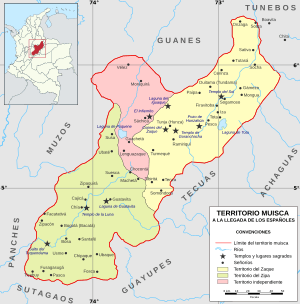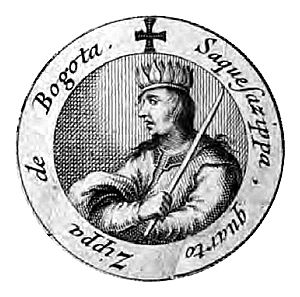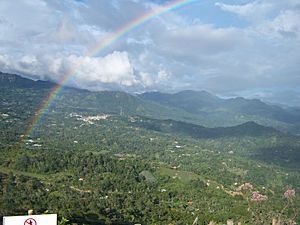Battle of Tocarema facts for kids
Quick facts for kids Battle of Tocarema |
|||||||||
|---|---|---|---|---|---|---|---|---|---|
| Part of Spanish conquest of the Colombian Andes | |||||||||
 Map of the Muisca Confederation Tocarema is at the border of Muisca & Panche |
|||||||||
|
|||||||||
| Belligerents | |||||||||
Zipazgo of the southern Muisca |
Caciques of the Panche | ||||||||
| Commanders and leaders | |||||||||
| Gonzalo de Quesada Juan de St. Martín Juan de Céspedes Pedro de Valenzuela Sagipa |
Anolaima, Cochima, Lutaima, Lichinú, Ibiantor, Calandaima, Iqueima, Tocarema, Buluduaima, Matima, & Siquima | ||||||||
| Strength | |||||||||
| 50-100 Spanish 4,000-20,000 guecha |
unknown | ||||||||
| Casualties and losses | |||||||||
| Fatalities: ~100 guecha Wounded: many Muisca ~30 Spanish |
unknown | ||||||||
The Battle of Tocarema was a fight between Spanish explorers and the Muisca people against the Panche people. It happened on August 19 and 20, 1538, in a place called Tocarema, which is now part of Cachipay, Cundinamarca, Colombia.
The Spanish were led by Gonzalo Jiménez de Quesada, a famous conquistador. The Muisca were led by their ruler, Sagipa, also known as the zipa. The Panche were a strong native group living in the area. The battle ended with a victory for the Spanish and Muisca forces. Even though they won, the Spanish had to fight the Panche again later to fully control the region.
Contents
What Led to the Battle?
When the Spanish arrived in Colombia, many different native groups lived in the Andes mountains. The Muisca people lived on a high plateau called the Altiplano Cundiboyacense. Around them lived other groups, like the Panche to the southwest.
The Muisca and Panche were often enemies. Spanish writers from that time said the Panche frequently attacked Muisca lands.
The Panche and Muisca People
The Panche were a fierce group of people. They lived in the lower mountain areas to the west of the Muisca. Many towns and rivers in Colombia today still have names from Panche leaders or communities. The Panche were known for their strong fighting spirit. At the time of the Spanish arrival, there were about 30,000 Panche people.
The Muisca people spoke a language called Muysccubun. Their land covered a large area, about 25,000 square kilometers (9,650 square miles). The Muisca lived in different groups led by their own chiefs, called caciques. The most important Muisca leaders were the iraca of Sogamoso, the tundama of Duitama, the zaque of Tunja, and the zipa of Bacatá. The Muisca were known as "The Salt People" because they traded salt, which was very important for their economy.
The Spanish Explorers
The Spanish explorers, also called conquistadors, had already taken control of some areas on the Caribbean coast of Colombia. They heard stories about a "city of gold" deep in the Andes mountains. This legend was known as El Dorado.
In April 1536, Gonzalo Jiménez de Quesada started an expedition to find this golden city. He led about 700 men from the coast into the unknown lands of Colombia. Many of his men died from sickness, hunger, or attacks by native groups.
After a difficult journey, the Spanish found salt loaves that were much better than the salt from the coast. They learned from the local people that this salt came from a rich civilization high in the Andes. This led them into the mountains, following what became known as "The Salt Route."
In March 1537, after almost a year, the Spanish army, now much smaller, reached Muisca territory. The Muisca gave them cotton clothes to protect them from the cold mountain weather. Jiménez de Quesada continued south to the land of the zipa of Bacatá.
The Spanish entered the Bogotá savanna in late March 1537. They defeated the Muisca zipa, Tisquesusa, in April 1537. The Spanish then set up a camp in Bosa. From there, Jiménez de Quesada sent out groups to explore more. He found rich emerald mines in the Tenza Valley.
After defeating other Muisca leaders, Jiménez de Quesada returned to the Bogotá savanna. On August 6, 1538, he founded the city of Santafe de Bogotá. After Tisquesusa's death, his brother Sagipa became the new Muisca leader. This was a bit unusual for Muisca traditions.
The Panche people learned about the Spanish arrival and their new rule. They launched an attack close to a Muisca settlement called Zipacón. This led to the Spanish and Muisca deciding to team up against their common enemy, the Panche.
The Battle
Sagipa and the Spanish leaders agreed to fight the Panche. On August 19, 1538, just two weeks after Bogotá was founded, the Muisca and Spanish forces marched west into Panche territory.
There were about 50 to 100 Spanish soldiers. The Muisca warriors, called guecha, numbered between 4,000 and 20,000. The Muisca started the attack while the Spanish hid nearby. This was a plan to surprise the Panche.
The battle happened in Tocarema, near today's Cachipay and Anolaima. The Panche used the hills to their advantage. They shot poisoned arrows at the Muisca warriors. About 100 Muisca warriors died, and many more were hurt. About 30 Spanish soldiers were wounded, but none died. As night fell, the Panche pulled back.
The next morning, August 20, Sagipa's troops moved forward. The Panche warriors attacked the Muisca in an open area. At that moment, the Spanish soldiers came out of hiding with their horses and weapons. Juan de Sanct Martín led the right side of the Spanish attack, and Juan de Céspedes led the left.
During the fight, Juan de Sanct Martín killed the main Panche chief, though he was wounded himself. Together, the Muisca and Spanish defeated the Panche. After their victory, the Spanish and Muisca returned to the Bogotá savanna and celebrated.
What Happened Next?

The alliance between Sagipa and the Spanish did not last long. After Gonzalo Jiménez de Quesada left for Spain in 1539, his brother, Hernán Pérez de Quesada, took charge. He demanded that Sagipa give the Spanish his valuable possessions. When Sagipa did not give enough, Pérez de Quesada ordered him to be punished.
The Panche people continued to resist the Spanish. Hernán Pérez de Quesada sent more expeditions into their lands. In August 1543, his captain Hernán Venegas Carrillo explored more Panche territories. He founded several new villages like Chaguaní, Bituima, Apulo, and Tocaima. The Spanish set up new settlements in Panche lands to control them.
Battle of Tocarema in Muisca History
See also
 In Spanish: Batalla de Tocarema para niños
In Spanish: Batalla de Tocarema para niños




